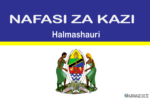AboutTaasisi ya Utafiti wa Maradhi ya Binadamu (NIMR)
The modern health research was introduced into the then Tanganyika (Tanzania) by the German Colonial government in the last quarter of the 19thCentury. During the early years of health research, the focus was on the major communicable diseases. Drs. Robert Koch and Gustav Giemsa were among the first scientists who will respectively be remembered for their contributions to the diagnosis of tuberculosis and malaria. After the World War 1, Tanganyika became a British Protectorate under the United Nations and the British continued with health research on specific disease problems to satisfy their need. It was during this post war period that institutionalised health research was initiated.
In 1922, the British Colonial Government established a Sleeping Sickness Service Unit in Tabora under the leadership of Dr. Frank Apted. The Unit was responsible for medical surveillance and treatment of sleeping sickness cases (Human African trypanosomiasis). In 1963 the Sleeping Sickness Unit was taken by the Ministry of Health of the Independent Tanganyika. The Unit which is now Tabora Research Centre is therefore the oldest Medical Research Unit in Tanzania.
In the Lake Victoria Zone, the British Colonial government launched researches on lymphatic filariasis with the establishment of the East African Medical Survey at Malya in 1947. The following year, (1948) a Filariasis Research Unit was opened in Mwanza. In 1954 the East African Medical Survey closed its offices in Malya and moved to Mwanza. In the same year the two units merged and acquired a new name, the East African Institute for Medical Research, under the East African High Commission.
Under the British Colonial and Welfare Scheme in 1949 an East African Malaria Unit (EAMU) was established at Ubwari, Muheza in northern Tanzania by Captain Dr. Bagster Wilson. In 1951, the Unit was moved to Amani in the East Usambara Mountains and was renamed East African Malaria Institute (EAMI) and became operational under the East African High Commission. In 1954, the EAMI was renamed the East African Institute of Malaria and Vector Borne Diseases (EAIMVBD).
After independence in 1961 and prior to the establishment of NIMR, public health research institutions in Tanzania were under the auspices of the East African Medical Research Council (EAMRC), established in 1957. Among the major objectives of the EAMRC included the recruitment of and training of indigenous research personnel from the member states of Uganda, Kenya and Tanzania. The EAMRC was also mandated to coordinate, set health research priorities, and submit research programmes, annual reports and financial statements. In 1968, the East African Medical Research Council established a Tuberculosis Investigating Unit (later National Tuberculosis Reference Laboratory) in Dar es Salaam. In the mid-1970s, the Medical Research Council of UK established Helminthiasis Research Unit at Bombo Hospital in Tanga.
Following the collapse of the East African Community (EAC) in 1977, all the institutions established under the EAC were rendered non-functional. These included all health research institutions in the country, which were previously being administered by the East African Medical Research Council. The Government of the United Republic of Tanzania therefore decided to re-organize the health research centres into the National Institute for Medical Research. NIMR was empowered to take over all health research institutions in the country which until the demise of the East African Community in 1977, were administered by the East African Medical Research Council.











